For as long as men have sailed the seas, they’ve been afraid of shipwrecks, particularly in the middle of the ocean. Suddenly losing the protection of the vessel that kept you above water, you find yourself cast into an environment almost completely alien from our own: having to constantly swim or float to keep from drowning, almost no way to get food, surrounded by poisonous water. Not to mention, all the creatures who live underwater that might decide to make a meal out of you.
The sailors aboard the warship USS Indianapolis found this out the hard way in 1945 when their ship was torpedoed by a Japanese submarine and sank in the Pacific Ocean. Those who weren’t killed in the attack found themselves in a whole new kind of Hell: cast adrift for several days, most without even the cursory protection of a life raft, almost completely helpless as they floated in one of Earth’s most hostile environments, waiting for rescue. It seemed like everything was trying to kill them: the sun, the water, their own bodies. But worst of all were the most feared denizens of the deep, leftover from a prehistoric age: sharks, which attacked the survivors without mercy for days, dragging men under the waves and leaving nothing behind but water stained red with blood.
By the time the survivors of the sinking were found, five days later, hundreds of men who’d survived the sinking had died of myriad different causes, including at least 200 who sharks killed. It was one of the worst disasters in the history of the US Navy: the story was so gruesome that the government hid the story from the American people for weeks, not even admitting the ship had been lost until the day the war ended, and censoring the more lurid details for years, even decades.
No one could believe that the world’s most powerful navy had simply lost one of its most prestigious warships and hadn’t even realized it: that hundreds of sailors had been effectively abandoned out of sheer incompetence. There were numerous investigations, court-martials, and Congressional inquiries into the disaster in the years and decades that followed the sinking, the results of which have generally satisfied nobody. All have tried to answer the same basic question: what happened to the USS Indianapolis?
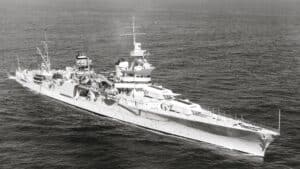
The VIP Vessel
USS Indianapolis (Hull Symbol CA-35), was commissioned into the United States Navy in November 1932. She was a cruiser, an intermediate vessel that was smaller than a battleship but larger than a destroyer, her heavy guns equally capable of engaging in ship-to-ship combat or bombarding shore installations. Like all other USN ships of this type, she was named for an American city, in her case the capital and largest city of the state of Indiana.
From the beginning of her service, the “Indy” seemed destined for important work in the Navy. She was chosen by new President Franklin D. Roosevelt in 1933 as his “ship of state,” the vessel he used whenever he needed to go to sea, participate in naval exercises or visit foreign nations. Indianapolis was part of the US Pacific Fleet when Pearl Harbor was attacked on December 7th, 1941, but was spared the destruction wrought on the battleships because she wasn’t in port at the time, she was several hundred miles away participating in an exercise.
Indianapolis saw heavy action in the Pacific Theater of the war, earning 10 battle stars. She was also chosen as the flagship of the 5th Fleet, ferrying around Admiral Raymond Spruance (famous as the victor of the Battle of Midway) to trouble spots all over the Pacific. The Indy was present at many of the most famous battles of the war: Tarawa, Saipan, Guam, Tinian, Peleliu, Iwo Jima, Okinawa. It was at Okinawa in March 1945 that she took her first serious damage of the conflict, taking a hit from a Japanese Kamikaze plane that killed nine sailors and did serious damage to the vessel, forcing it to return to the United States for repairs.
It was expected the ship would be out of action until the fall of 1945 when she would return to support the Allied effort to invade the Japanese home islands. But in mid-July, her captain, Charles McVay, a career Navy man whose father had been an admiral, received new orders, orders that came from President Truman himself. The Indianapolis was to take some mysterious cargo (nobody would tell the crew what it was) to the island of Tinian, at “best possible speed,” and to let nothing interfere with that mission. The ship left San Francisco, passing under the Golden Gate Bridge, on July 16th, 1945. Most of her 1,196 crewmen would never see it again.
Disaster
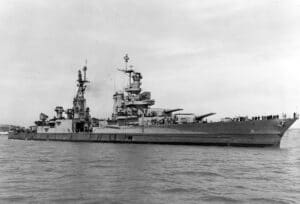
The ship set a record on the journey, traveling from California to Pearl Harbor in 74 and a half hours, then raced on to Tinian, where her cargo was unloaded. Captain McVay could now breathe easier, his mysterious mission having been accomplished. He wouldn’t find out until later that he had just delivered the components necessary to assemble the “Little Boy” atomic bomb, which would be dropped on the Japanese city of Hiroshima ten days after being unloaded from the Indy.
Indianapolis moved on to the island of Guam to receive new orders: she was now to travel to the Filipino island of Leyte, where her crew would receive additional gunnery training before “getting back in the war.” 36 hours after leaving Guam, the ship was cruising uneventfully through some of the most remote regions on Earth: not only does this area of the Pacific Ocean contain virtually no islands, but it is also home to some of the deepest water on the planet. The ship was alone: it was decided that, this being a relatively “safe” area far from the frontlines, the Indianapolis didn’t need an escort.
The problem was, the ship WASN’T alone. The Japanese Navy had been almost completely destroyed by this point in the war, but still had a few vessels capable of doing damage, particularly its submarine force. One of these, the I-58, spotted the Indianapolis on the night of July 30 and began maneuvering to fire on it. The crew of the Indy had no idea that the Japanese sub was there: the ship had no equipment to detect submarines because that was the job of the smaller destroyers, who normally provided an escort to larger ships in hostile waters.
At approximately 12:05 AM on July 31st, Indianapolis was struck by two torpedoes on her starboard (right) side. The first one blew off the front part of the ship, called the bow, completely, while the second one hit in the middle, tearing a huge hole in the side of the ship. The resulting explosions and fire killed many of her crew almost instantly and seriously injured many more. Captain McVay, who’d been asleep when the torpedoes had struck, attempted to implement damage control measures to save his ship, but it quickly became apparent that there was nothing they could do. He gave the one order no ship captain ever wants to give: “Abandon ship!”
Flotsam and Jetsam
Things were moving far too quickly for anything like an orderly evacuation to take place. Only a few of the life rafts and other survival equipment could be deployed: most of the sailors had to jump overboard with nothing but the clothes on their backs (if they had that, many were actually naked), and a life vest. Many didn’t get off the ship at all: it only took twelve minutes from the time of the attack for the Indianapolis to capsize and sink, taking an estimated 300 sailors with her.
Those who survived the sinking now found themselves adrift in the ocean, hundreds of miles in any direction from land, with little to no food, almost no fresh water, no medical supplies, and no protection from the elements. Whether they lived or died depended on being rescued, but this was complicated by the fact that Indianapolis had been alone when she sank: there were no escort vessels to pick up survivors. However, the sailors were optimistic that the Navy would come to get them: even if they hadn’t managed to send a distress signal out before the ship sank, surely somebody would notice when they didn’t show up in Leyte as scheduled, and come looking for them?
They just had to survive until then, which wasn’t an easy prospect. The survivors had to face numerous dangers, most of which are unfamiliar to us in our day-to-day lives on dry land. The ocean water itself is hostile to human beings: it’s totally fine for a day at the beach, but if you spend hours upon hours submerged in it, the way the survivors did, your skin will eventually start to develop rashes and sores from the constant exposure to the saltwater. The temperature of the water was also a problem: 85 degrees Fahrenheit at night might seem pleasant, but again, constant exposure gradually lowers a person’s body temperature until they begin suffering from hypothermia.
Conversely, when the sun came out, it reflected off the water brilliantly, dazzling the survivors and forcing them to use makeshift blindfolds to protect their eyes. This close to the Equator, the sun’s rays are merciless, and parts of the survivor’s bodies that were above the surface of the water, their heads and arms particularly, became severely sunburned. All of this contributed to dehydration, and the constant presence of the ocean raised the sodium content in their bodies, putting them at risk for a fatal condition called hypernatremia, literally a “salt overdose.” But the most horrifying danger, as the sailors would soon discover, wasn’t the water: it was what lived in it.
From the Deep
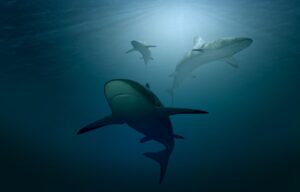
Sharks are often referred to as “nature’s perfect predator,” and there is a lot in favor of that argument. They are some of the oldest surviving animals on the planet, dating back some 400 million years, and in the deep ocean, they hold all the advantages over a man, and that’s someone who’s healthy and prepared to square off against them. The Indianapolis survivors were neither of those, and the sharks were about to take full advantage of an easy meal.
According to marine biologists, the sharks, most of which were believed to be of the whitetip and tiger species, had likely been following the Indianapolis since she left Guam: they know to follow large ships and feed on garbage that is routinely dumped overboard. They’d spent most of the first two days after the sinking feeding on the dead, but now they were starting to pay closer attention to the large groups of survivors that had lashed themselves together to stay close. Sailors began to feel the sharks “bumping” into them, a hunting technique they utilize to stun their prey before attacking. Then the horror began.
Without warning, a survivor would disappear, leaving nothing behind but an empty life vest and a blood stain. A man would attempt to wake what he thought was a sleeping comrade, only to tip him over and realize that the entire lower half of his body had been eaten during the night. As time passed, the sharks became bolder, coming close enough to the surface for their distinctive dorsal fins to appear out of the water. The survivors tried to fend them off as best as they could, but they had few weapons that were effective against a 12-foot-long fish with a mouthful of razor-sharp teeth.
As the hours turned into days, optimism transformed into despair. The combination of mental and physical distress on their bodies caused most of the survivors to slip into various states of delirium. Many of the survivors experienced hallucinations: the Indianapolis returning to pick them up, a small island made entirely of vanilla ice cream, or their neighbor was actually a Japanese spy. The men began to act irrationally: many, unable to take the strain any longer, effectively committed suicide by drowning themselves or allowing themselves to be taken by the sharks. There were also cases where delusional men killed each other, convinced that they were actually the enemy in disguise. And of course, many men tried to slake their unending thirst by drinking seawater, which in their situation was effectively a death sentence, rapidly accelerating dehydration and the onset of hypernatremia.
Rescue
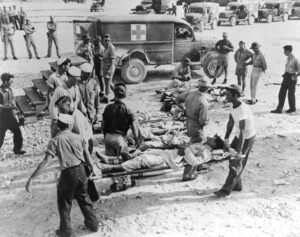
While the crew of the Indianapolis were fighting for their lives in the water, Navy officials remained completely unaware that anything had happened to the ship at all. The reasons for this were numerous: various interpretations of Navy policy, multiple instances of miscommunication between the various Pacific island stations the Indy had visited on her final cruise, and several false assumptions and attitudes of complacency on the part of port officials, particularly those in Leyte. The bottom line was that nobody knew that Indianapolis was missing because everyone assumed the cruiser had gone somewhere else, and just hadn’t bothered to tell them about it. It wasn’t the first time that had happened, after all: sometimes in a war as large as this, paperwork gets misrouted or isn’t completed at all.
But this failure was costing the lives of hundreds of men. And if a Navy antisubmarine plane on a routine patrol hadn’t stumbled on the men drifting in the water by accident, three and a half days after the sinking, every single one of them would likely have died. Fortunately for the survivors though, they WERE spotted, and to the Navy’s credit, once they realized, belatedly, what had happened, they pulled out all the stops to rescue as many of the survivors as they could. All available ships and aircraft were directed to join the massive rescue effort: one floatplane pilot made the brave decision to land his plane in the open ocean, where it served as a more sturdy life raft for as many survivors as it could carry. The plane was so damaged that it was unable to take off and had to be scuttled by her crew.
The men pulled out of the water were in a horrible condition: in many cases, the skin was peeling off their bodies, the result of constant exposure to a toxic mix of saltwater and the fuel oil that had spilled from the Indianapolis when she sank. Most of them were malnourished, and all of them had suffered from dehydration and exposure to the elements. One sailor lost over 35 pounds of body weight during his time in the water. But all things considered, they were the lucky ones: it is estimated that between 800 and 900 sailors survived the sinking of the Indianapolis, but by the time they were rescued four days later, only 321 men were pulled out of the water alive.
Four of these men would later die in the hospital, leaving a total of 317 survivors out of an original crew of nearly 1,200 sailors. The 879 dead represented the second largest loss of life aboard a single ship in US Navy history, trailing only the 1,177 men who were killed aboard the USS Arizona when she blew up during the attack on Pearl Harbor. It is estimated that as many as 200 of the survivors were killed by the sharks, representing the largest shark attack in recorded history. The story was so horrific, the loss of life so huge, that the government decided to censor the news from the American people, fearing a loss of morale. The first the public heard about the disaster was two weeks after the sinking, the same day that President Truman announced that Japan had surrendered to the Allies, ending World War II.
Aftermath
The Navy investigation into the disaster revealed several failings in Navy policy: four officers were given letters of reprimand as a result of their failure to realize the Indianapolis had been in trouble. It would be revealed later that the ship HAD sent a distress message prior to sinking, and three different stations picked it up, but no one took any action, believing it to be a Japanese hoax.
The harshest official criticism, however, was reserved for the ship’s commanding officer. Captain McVay had survived the sinking, being one of the last men to leave the ship. The Navy made the incredible decision to court-martial the captain, on the charge of “hazarding his ship,” the only captain in US Navy history to be court-martialed after losing his ship to enemy action. The point of contention was McVay’s decision the night of the attack to cease the ship’s “zigzagging” maneuvers, which were supposed to be a way to prevent hostile vessels from getting a fix on the ship. McVay had been given discretion to stop zigzagging at night if visibility was poor, but the prosecution argued that, since the Japanese submarine was able to see the Indianapolis to torpedo her, that visibility couldn’t have been that poor.
To prove this point, the prosecution made the controversial decision to call the commanding officer of the I-58 that night, Lieutenant Commander Mochisura Hashimoto, to testify during the proceedings. The move sparked outrage across the country, further reinforcing the view of many that McVay was being made a scapegoat, and it didn’t even help the prosecution’s case: Hashimoto testified that it wouldn’t have made much difference if the ship HAD been zigzagging, he would have sunk it anyway.
Regardless, the court-martial convicted McVay of the charge, and he was punished by stripping him of his seniority in rank, essentially destroying any chance of future promotion and thus, his career. He never commanded a ship again, retiring in 1949 after a series of desk jobs. The sinking haunted the captain for the rest of his life: while most of the survivors supported their former commander, McVay regularly received hate mail from relatives of sailors who’d been killed, blaming him for their loved ones’ deaths. In 1968, Charles McVay committed suicide with a handgun at his home in Connecticut, apparently dreading another Christmas season, which was when the majority of the letters came in.
Legacy
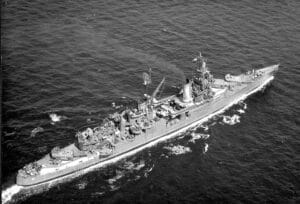
A new generation of Americans was introduced to the tragedy of the Indianapolis in 1975, with the release of the hit movie Jaws. In that film, the character Quint, played by Robert Shaw, is a survivor of the sinking and describes in graphic detail what happened to him and his shipmates, particularly focusing on the shark attacks. The film made the career of the young director Steven Spielberg and was the highest-grossing movie of all time when it was released.
The survivors of the sinking, who went on to have a myriad of civilian careers ranging from bricklayers to corporate executives, held their first reunion 15 years after the sinking, in 1960. In the 1990s, they were at the forefront of the effort to posthumously exonerate Captain McVay, particularly after declassified intelligence from 1945 showed that senior Navy officials knew there had been Japanese submarine activity in the area, and failed to warn the captain, who surely would have insisted on an escort or taken a different route had he known. McVay was formally exonerated by an Act of Congress in 2000, with the Navy entering it into his personnel record the next year.
Almost all of the Indianapolis survivors are gone now: as of 2024, there is only one man still alive: 97-year-old Howard Bray, who was only 17 when he survived the hellish ordeal. As for the ship itself, she lies where she sank, 18,000 feet below the surface of the Philippine Sea (5,500 feet deeper than the wreck of the Titanic). The wreck was discovered in 2017 by an underwater submersible and is considered to be in “relatively good condition” for a shipwreck because of the extreme depth she lies at. The Navy considers her a war grave, not to be disturbed without explicit permission, because of the hundreds of sailors who are entombed within her.
Many hard lessons were learned because of the sinking of the Indianapolis. Because of her loss, the Navy created the Movement Report System (MOVREP), a system still used today (albeit in an electronic, as opposed to manual, form) to ensure that top Navy brass know where every ship in the fleet is at all times, to prevent another tragedy caused by losing track of where ships are. Lifesaving equipment, such as life jackets and emergency rafts, were modified to make them tougher and easier to use. But the hardest lesson to learn was something sailors have always known since ships first began to take to the waves: the ocean is a dangerous place, and if you end up in her clutches, you are at the mercy of both it…and the creatures that live beneath its surface.





